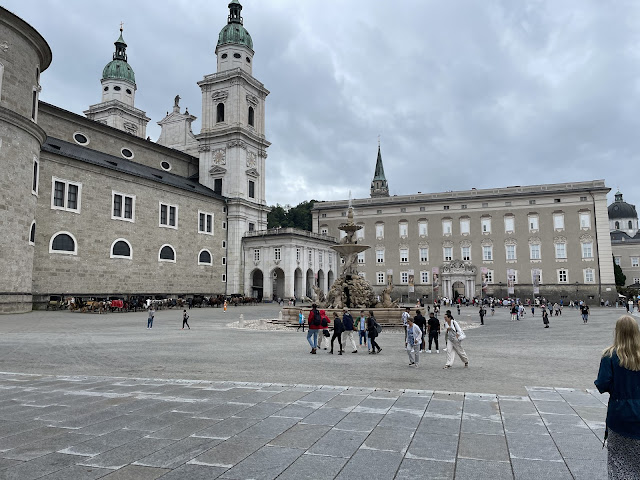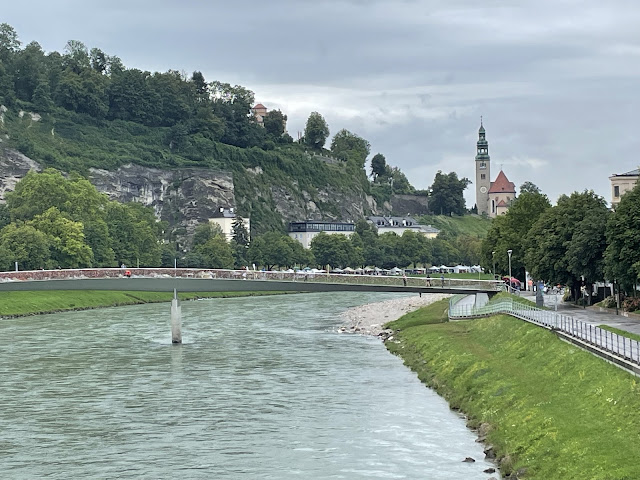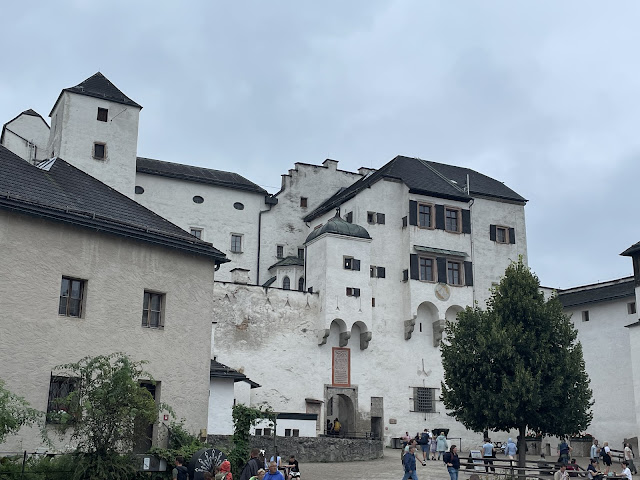We woke up to a fairly damp morning, with lots of cloud and rain, but thankfully the worst of the storm had passed over. The Freilassing train station was only a 15min walk away, so we caught a train into Salzburg.
At this point in the trip we were starting to get a bit fatigued from being on the road so, while we were excited to explore Salzburg, we were also feeling a pretty flat.
From the train station we started our way into the city.
Salzburg is built on the site of the old Roman town of Luvavum and made most of its money through salt mining (hence the name - Salt-City).
Our first stop was St. Andräkirche - St. Andrew's Church. The church was originally in the Platzl (Town Square) but it was demolished to widen the road. The new church was built in Mirabellplatz in the Neo Gothic style. It was partially destroyed by bombing in World War II and was repaired and remodelled in 1970.
From there we continued to the Mirabell Palace - built in 1606 for the Prince Arch-Bishop Wolf Dietrich Raitenau. Raitenau had gout and had suffered a stroke, so wanted a pleasure palace that allowed him to avoid Salzburg's narrow streets.
Raitenau was arrested and deposed in 1612 and his mistress was expelled from the palace and it was rebuilt in Baroque form. The palace was again changed to neoclassical in 1818 and was bought by the city of Salzburg in 1866.
Several parts of the Sound of Music were shot in the palace. We didn't spend long there as the rain had driven several tour groups inside and the place was packed.
Our next stop was the dreifaltigkeitskirche (Church of the Holy Trinity), built in 1694:
Then the Salzburger Landestheater, built in 1892:
and the Müllner Kirche (Müllner Church) - which was visible at the end of the river:
Our path then led us to one of the main tourist parts of Salzburg old town and Mozart's Birthplace. The third floor of number 9 Getreidegasse was the home of the Mozart family in the years 1747-1773. Wolfgang Amadeus Mozart was born at home on 27th Jan 1756. The house itself was built in the 12th century and has since become a museum to Mozart:
We then spiraled into the center of old town, passing a few more notable buildings:
Kollegienkirche (Collegiate Church), built in baroque style in 1707 it is now the parish church for the University of Salzburg:
We also passed the Marktbrunnen for the Almcanal in Universitätsplatz. This is a freshwater drinking fountain that supplies water from the underground Almcanal:
We then hit the main area of Salzburg old town, coming to the Town Hall, Cathedral and Fountain.
The Old City Hall (Altes Rathaus) is the former city hall for Salzburg. Originally a Burgher's house in the 1300s, the house was purchased by the city in 1407 and used as the seat of government and court. The Façade is Rococo design:
In old town square is the St Florian Fountain (Florianibrunnen). Originally a well, the first center of the fountain was constructed in 1488. The well pulled water from underground pipes connecting to the Gaisberg mountain. The current fountain was built in stages. The metal fence is the oldest part (1583). The baroque parts of the fountain such as the central pillar and basin were made in the late 1680s. The statue, St Florian (the patron saint who protects buildings from fire) is the newest part, dating from 1734:
The main feature of the square is the Salzburg Cathedral, Salzburger Dom. The first church on the site was built in 774 and rebuilt in 1181 after the original was destroyed in a fire from a lightning strike. In 1598 the church was demolished after it was severely damaged and the new church was completed in 1628. It is designed in the baroque style and contains the baptismal font in which Mozart was baptized.
The square in front of the cathedral is named Residenzplatz. The square was created in 1587, replacing a former medieval cemetery attached to the church. The square was originally named Hauptplatz (Main Square).
To the south of the square is Salzburg Cathedral, to the west is Alte Residenz (Old Residence), to the east is Neue Residenz (New Residence, 1588 with bell tower) and to the north are many private houses.
In the centre of the square is the Residenzbrunnen (Residence Fountain), built in 1656 from Untersberg limestone. It is the largest baroque fountain in Europe:
 |
| Neue Residenz |
 |
| Clock tower of the Cathedral |
 |
| Neue Residenz |
 |
| Cathedral, fountain and AlteResidenz |
 |
| When your horse has sinus issues... |
We then headed to our last stop - the Festung Hohensalzburg (High Sazburg Fortress) .The fortress sits on the Festungberg mountain, 506m above the town and is one of the largest medieval castles in Europe (250m long and 150m wide). Construction on the current castles started in 1077, but excavations show that fortifications had been present much longer, including a Roman fort.
The original design was a bailey with wooden wall, which was expanded to add ring walls and towers in 1462.
The fortress was only ever attacked once, in 1525 during the German Peasant's War when miners, farmers and townsfolk failed to take the fortress. It was surrendered without a fight to Napoleon in 1800 and was used as a barracks, storage depot and prison.
The castle was easily visible from around the town:
We took the funicular (Festungsbahn) up to the castle. It was fairly expensive, but included entry to the castle:
The boys found a traditional medieval foosball table and an intense battle broke out even though they could barely see through the rain soaked lid. Cam won fairly convincingly, even when I stepped in to help Tomas.
 |
| "You can see there the fine Baroque designs, definitely influenced by the late Renaissance period..." |
 |
| Model of Salzburg |




























































No comments:
Post a Comment